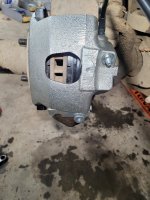Did some more tests and came back inside to thaw out.
With rear brakes plugged off...
- Front driver caliper = 500psi (no change)
- Pedal resting height from floor = 5.75"
- Pedal min height from floor
-- Engine ON = 2.75"
-- Engine OFF = 1.5"
- 1.5 oz of fluid after 5 pumps from caliper bleeder
- 1.5 oz of fluid after 5 pumps directly from MC port
- 1500 psi direct from MC to caliper using a 15 foot coiled steel line

With rear brakes unplugged...
- Pedal resting height from floor = 5.75" (no change)
- Pedal min height from floor
-- Engine ON = 2.25"
-- Engine OFF = 1.25"
- 1500 psi direct from MC to caliper using a 15 foot coiled steel line
No observed no air bubbles in the PS reservoir in case anyone is wondering.
Pads appear to be in light contact with rotor when brakes not engaged. I can still turn rotor and there is not a noticeable gap.
Why am I losing 1000 psi when plumbed directly to the caliper?
If I assume each caliper is absorbing 1000 psi, then net 500 psi measured at each seems to make sense since the pressure would balance between the two, correct
2500 MC
-1000 caliper
-1000 caliper
-------------
500 leftover between the two?
As far a volume is concerned, if I'm getting the same volume from both the MC and the caliper, I'd say there's no restriction in the lines but, barring some issue with the calipers binding, I can't help but think I need a larger MC although I swear people running Explorer rear discs and T-Bird front discs are using 1-1/8"
Next, I'll bypass the frame to axle line with the large steel line and see what measurements I get just to rule out the hose once and for all.
Also need to really look at how the caliper is moving in the knuckle.
But if the caliper is grounding out on the knuckle, the outer pad won't have contact with the rotor. As pressure builds the piston will press the inner pad to the rotor and the rotor can flex. This will be a point where there is expansion (fluid flowing with minimal pressure increase). That is why I was suggesting checking caliper clearance.
Are y'all suggesting if I remove the pads and mount the caliper, it should slide laterally by hand?














